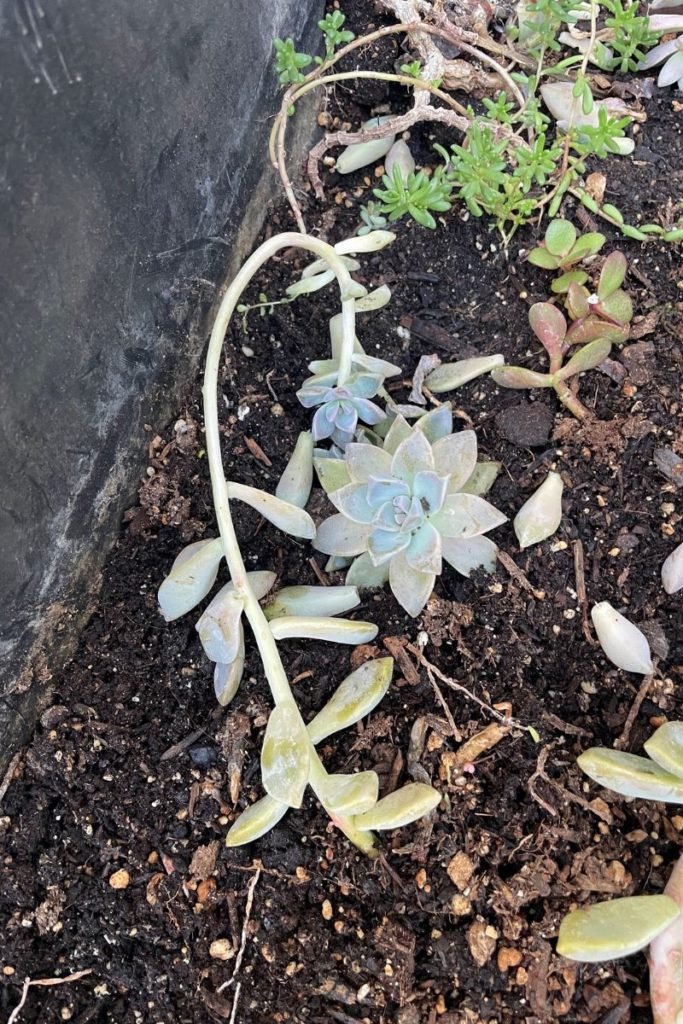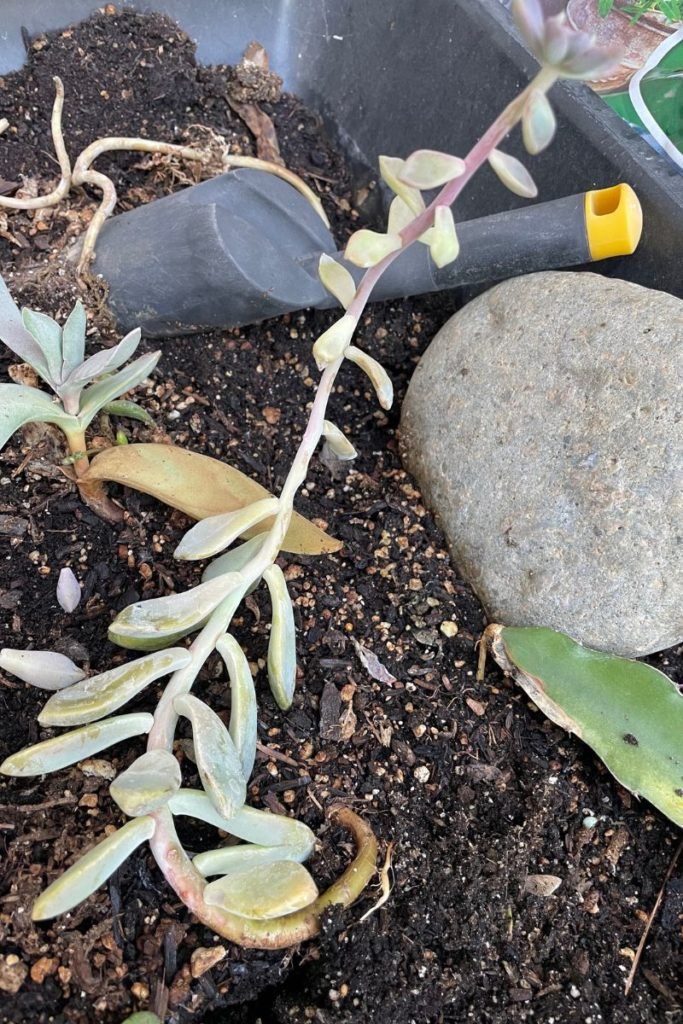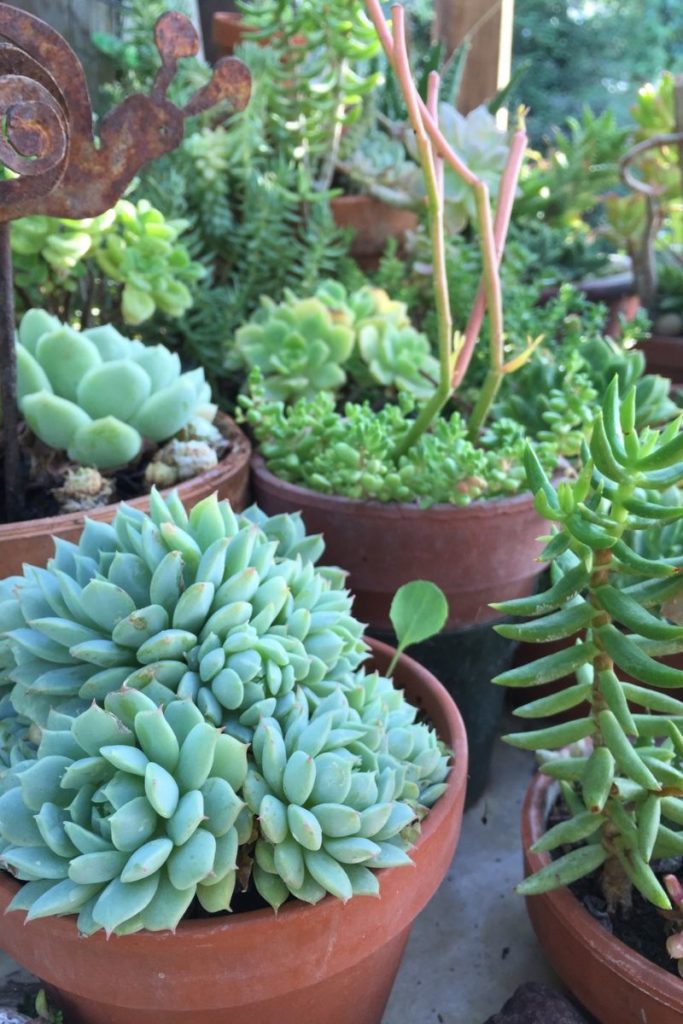Plants are older than time, which means they’ve known how to survive for a really long time.
Though they don’t have legs, plants can creep and crawl along Earth’s surface until it finds what it needs to survive, including adequate sunlight.
And when these sun-loving succulents grow tall, that often means they’re reaching for sunlight.
The good news is that it’s an easy fix: give it more light.
The bad news is that leggy succulents look weird.
Let’s walk through my tips for growing succulents indoors. With proper care, you too can have juicy, healthy succulents.
Plus, I’ll go through the steps for propagating new succulents so that you can turn that stretched out succulent into AN ARMY OF SUCCULENTS mwa hahaha.
Why do succulents stretch out?
Succulents are sun worshippers – they need a lot of it to thrive. Without enough light, they’ll start to stretch out, reaching for the sky like a yoga pose gone wrong.
The result? A leggy, tall succulent, that looks more like a caricature of itself than the cute and compact plant you fell in love with.
This leggy new growth is called “etiolation”.
This is quite common with indoor succulents as succulents thrive, well, outdoors.

What causes etiolated growth?
Etiolated growth – it sounds like a fancy medical term, doesn’t it? But really, it’s just a fancy way of saying “leggy succulent.” It happens when your succulent isn’t getting enough light, and its stem starts to stretch out in search of more.
Succulent stretching isn’t the only thing that happens when succulents don’t get enough sunlight.
Just like a person who spends all their time inside and never gets any sun, a succulent that’s not getting enough sunlight will start to get pale and spindly. The stem will elongate, and the leaves will become smaller and more tightly spaced. It’s like the succulent is trying to tell you, “I need more light, please!”

What to do when your succulent gets too tall
Fixing the issue is as simple as finding the right spot for your succulent to soak up the sun. A south-facing window or a grow light will do the trick, and your succulent will soon be back to its compact and healthy self, ready to strike a pose and bask in the sunshine.
Unfortunately, you can’t reverse leggy growth, but you can take steps to ensure that future growth is healthy and compact.
womp womp
To prevent succulents from getting stringy, you can move your succulent closer to a light source or add a grow light to provide it with more sunlight. Just be sure to increase the amount of light slowly to avoid any sunburn.
I find most succulents seem to be happiest in direct sunlight BUT if your succulents haven’t had much exposure to direct sunlight then you’ll need to break them into it. Start with indirect sunlight and work your way up to more light over the course of three weeks.
The same principle applies with a grow light. Start small and work your way up.
And if you’re feeling really adventurous, you can even chop your leggy succulents and propagate them. It sounds scary, but propagating succulents is actually super easy.
To propagate your succulent, simply cut off the top of the leggy stem with a sharp pair of gardening scissors, leaving a few inches of stem below the rosette of leaves.
Let the cutting dry out for a few days until the wound has calloused over, and then plant them in well-draining succulent soil.
Keep the soil moist but not too wet, and within a few weeks, you’ll see new roots and leaves sprouting up.
And voila – you’ll have a brand new, healthy-looking succulent to enjoy, like a plant version of a phoenix rising from the ashes.

Tips for healthy succulents
There are two other things that succulents need: lots of water and lots of drainage.
Since these plants store water in their leaves, it’s important to give them a good supply of water regularly.
Think: torrential downpour in the desert. Or coastal mist all day long. (⬅️ two environments that succulents thrive in.)
But because succulents have fine hair-like roots, it’s important that the water drains freely and quickly.
Again, think: rocky and sandy desert or rocky and sandy beach.
A formulated soil mix will do the trick.
By providing these environmental factors for your succulents, you’ll give them what they need to grow thick and juicy 💦
And to prevent tall succulents, give them plenty of light.
Closing thoughts
Succulents may be ancient beings that have survived for millions of years, but they’re not immune to the challenges of modern life. Like us, they can get a little too much or too little of what they need, and their bodies will respond in kind.
So when succulents grow tall, that means they lack sunlight and are reaching for as much light as possible.
But the good news is that fixing leggy succulents is usually as simple as finding the right spot to bask in the sun. And if all else fails, you can always chop and propagate your plant like a horticultural mad scientist.
So, don’t be discouraged if your succulent starts to grow tall and skinny. Think of it as an opportunity to get creative and experiment with different growing techniques.
Who knows – you might end up with a whole army of healthy, happy succulents that will bring joy to your life for years to come. And if not, well, at least you tried – and you’ll always have the memories of that one time you tried to save your succulent and ended up with a house full of baby plants. Life is funny like that.
more about succulents
- Growing ZZ Plants: How To Care For A ZZ Plant
- How To Save An Overwatered Snake Plant
- 7 Best Succulents For Beginners (Buy Live Plants Online 🚚)
- How to repot succulents: a beginners guide to repotting succulents
- [SOLVED] Why is my succulent growing tall and skinny?
- Underwatered aloe plant: how to know when your plant needs more water
- How to cut aloe vera plant without killing it

![[SOLVED] Why is my succulent growing tall and skinny?](https://theindoornursery.com/wp-content/uploads/2023/04/why-is-my-succulent-growing-tall.jpg)



